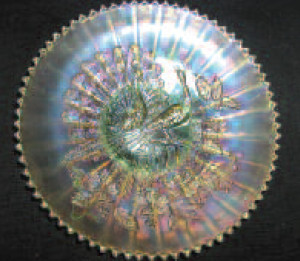In an article written by Martie Grubenhoff in 2008 we learned that Carnival glass has been around for over one hundred years, gaining popularity in the collecting world from the 1950’s. The pressed and iridized glass was dubbed carnival glass when it was given as prizes at carnivals. It was inspired by the beautiful costly art glass produced by Tiffany and others from 1905 through the 1930’s. Besides production in the United States, carnival glass was produced in several European countries as well. In the US there were many companies that manufactured carnival glass, including Dugan, Fenton, Imperial, Millersburg, Northwood, Cambridge, Jenkins, Westmoreland, Fostoria, Heisey, McKee, and US Glass. Many of these companies are recognized by collectors of Early American Pattern Glass and Depression Glass as well. Of the companies mentioned, Fenton produced more Carnival Glass patterns than any other American company.
Carnival glass comes in a variety of colors from the more commonly recognized marigold (an amber color) to green, cobalt blue, red, amethyst, to the more unusual white, ice blue and others. The Standard Encyclopedia of Carnival Glass by Bill Edwards lists about fifty different colors. Most of the carnival glass pieces are pressed into a mold like its glass cousins Pattern Glass and Depression Glass. To make the iridized effect, the piece is sprayed with a sodium solution and fired to give it the exterior lustrous finish. A collector can find a myriad of pieces in carnival glass including plates, bowls, pitchers, decanters, vases, tumblers, candlesticks, lamp shades, goblets, punch sets, baskets, table sets, powder jars and more. There are hundreds of patterns including flowers, fruits, birds and other animals, geometric motifs. Among the popular patterns are Northwood’s Grape and Cable, Peacock at the Fountain, and Fenton’s Orange Tree, Butterfly and Berry, Dragon and Lotus, to name a few. Several of the companies known for Depression Glass issued carnival glass pieces in patterns such as Floragold and Iris and Herringbone by Jeanette.
There have been reproductions over the last forty years, including pieces made by Indiana Glass during the 1970’s around the time of the US bicentennial. Even these pieces are sought by collectors. Fenton continued to produce Carnival Glass into the 21st century.
The value of a piece is determined by its shape, color and condition. Some pieces are common in one color but rare in another. The iridized finish can wear which would affect the value of a piece. A chip can diminish significantly a piece’s worth as well. There are a number of books that are full of useful information that can be found at your local library or bookstore.
















Follow Us